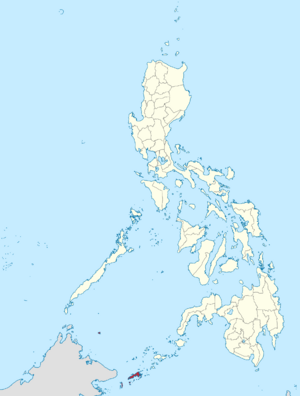Sulu bleeding-heart facts for kids
Quick facts for kids Sulu bleeding-heart |
|
|---|---|
 |
|
| Conservation status | |
| Scientific classification | |
| Genus: |
Gallicolumba
|
| Species: |
menagei
|
 |
|
| Map of the Philippines highlighting Tawi-tawi | |
| Synonyms | |
|
|
The Sulu bleeding-heart (also called the Tawitawi bleeding-heart) is a special type of bird in the pigeon and dove family. Its scientific name is Gallicolumba menagei. This bird is only found on the island of Tawi-Tawi and the small islands around it. These islands are part of the Philippines' Sulu Archipelago.
Scientists have only seen two of these birds for sure, both collected in 1891. Since then, no one has officially confirmed seeing them again. The Sulu bleeding-heart lives in thick, old forests and also in newer forests where the tree branches form a closed roof, called a canopy.
This pigeon is a medium-sized bird with a short tail. It has bright, shiny green feathers on its head and back. On its chest, it has a large, light orange spot that looks like a "bleeding heart," which is how it got its name. Its lower wings and back are brown, and its throat and chest are mostly white. Its belly is a gray color.
Like other bleeding-heart pigeons, the Sulu bleeding-heart mostly stays on the ground. It looks for food there and only flies short distances. Not much is known about how it behaves because it's so rare. Even though searches in 1971 and 1991 didn't find any, some local people said in 1995 that the bird was common until the 1970s and might still live on small nearby islands.
Most of the forests where this bird lives on Tawi-Tawi were cut down by 1994. Because of this, and because it's so hard to find, the Sulu bleeding-heart is listed as critically endangered. This means it's at a very high risk of disappearing forever. If any are left, there are probably fewer than 50 of them. They are threatened by losing their homes and by hunting.
Contents
What is the Sulu Bleeding-Heart?
The Sulu bleeding-heart is a unique bird that belongs to the pigeon and dove family. It's known for the distinctive orange-red patch on its chest. This bird is very shy and lives hidden in dense forests.
Where Does the Sulu Bleeding-Heart Live?
This bird is found only in a specific part of the world. It lives on the island of Tawi-Tawi and the small islands close to it. These islands are in the southwestern Philippines, in an area called the Sulu Archipelago. It prefers forests with a thick, closed canopy, where the trees' branches meet overhead. On smaller islands, it can also live in forests near the beach.
Why is it Called a Bleeding-Heart?
The name "bleeding-heart" comes from the special mark on its chest. It has a large, pale orange spot that looks like a drop of blood. This unique feature helps identify it from other birds.
How Was the Sulu Bleeding-Heart Discovered?
The Sulu bleeding-heart was first officially described in 1894. Two scientists, Frank Swift Bourns and Dean Conant Worcester, gave it the scientific name Phlogoenas menagei. They found the first male bird in October 1891 on a small island called Tataan, near Tawi-Tawi. The name menagei was chosen to honor Louis F. Menage, who helped pay for their trip.
Is it Related to Other Birds?
Yes, the Sulu bleeding-heart is part of a group of similar birds called "bleeding-hearts." This group includes the Luzon bleeding-heart, Mindanao bleeding-heart, and Negros bleeding-heart. These birds look so much alike that some people thought they were all the same species. The Sulu bleeding-heart does not have any known subspecies, meaning there are no distinct variations of it. It is also sometimes called the Tawitawi Puñalada.
What Does the Sulu Bleeding-Heart Look Like?
The Sulu bleeding-heart is a medium-sized pigeon with a short tail. It measures about 25 to 27 centimeters (10 to 11 inches) long. Its weight is not known.
Feather Colors and Patterns
- Head and Upper Body: Bright, shiny metallic green feathers cover its forehead, crown, and upper back.
- Wings: The feathers on its shoulders are dark brown with a shimmering edge that can look violet, green, or lilac. The main wing feathers are dark brown, and some have gray tips.
- Tail: The upper part of its tail is reddish-brown with a narrow metallic green or violet edge. The center of the tail is dark brown, and the edges are gray with a wide black band.
- Underparts: The area around its eyes is black. Its chin, throat, and chest are pure white. The upper chest has large patches of metallic green feathers, similar to its back. Between these green patches is the famous pale orange "bleeding-heart" spot. Its belly is a gray color.
- Eyes, Beak, and Feet: Its eyes are a light silver-gray. The beak is black with a gray tip, and its feet are red.
How to Tell it Apart from Other Birds
It can be tricky to identify the Sulu bleeding-heart because other similar doves live on Tawi-Tawi.
- Emerald Dove: This bird looks similar but has a larger, whiter patch on its shoulder and dark brown underparts.
- Other Bleeding-Hearts: Sometimes, other bleeding-heart pigeons, like the Luzon or Mindanao bleeding-hearts, might escape from being pets. The Sulu bleeding-heart is different because it doesn't have the purple neck and back of the Luzon bleeding-heart. It also doesn't have the clear gray wing-bars or orange belly of the Mindanao bleeding-heart.
Scientists have never heard or described the sounds the Sulu bleeding-heart makes.
How Does the Sulu Bleeding-Heart Behave?
Like its relatives, the Sulu bleeding-heart is mostly a ground bird. It spends most of its time on the forest floor, searching for food. It only flies short distances, usually to roost (rest) in trees or to mate. When it feels scared, it quickly runs into nearby bushes to hide. Because it's so rare and shy, not much else is known about its daily life or habits.
Why is the Sulu Bleeding-Heart Endangered?
The Sulu bleeding-heart is listed as critically endangered by the IUCN, a group that tracks threatened species. This means it faces a very high risk of becoming extinct.
History of Sightings
- 1891: The last time anyone definitely saw a Sulu bleeding-heart was in October 1891, when two male birds were collected on Tataan islet.
- 1971 and 1991: Scientists searched for the bird for 22 days in December 1971 and again briefly in September 1991, but they didn't find any.
- 1994: Most of the forests on Tawi-Tawi, where the bird used to live, were cut down by August 1994. This means the bird might no longer exist on the main island.
- 1995: A survey that talked to local people in 1995 found reports that the bleeding-heart was still alive and seen regularly on nearby small islands like Tandubatu, Dundangan, and Baliungan. Locals also said the bird was quite common until the 1970s.
- 2009: Despite these hopeful reports, another trip in 2009 failed to find any signs of the bird.
Threats to Survival
Any remaining group of Sulu bleeding-hearts is likely very small, possibly fewer than 50 birds. They face two main dangers:
- Habitat Destruction: Their forest homes continue to be cut down.
- Hunting: Uncontrolled hunting also threatens them.
Since other bleeding-heart pigeons are popular as pets, any bleeding-heart found on Tawi-Tawi could also be an escaped pet bird, not a wild Sulu bleeding-heart. There are no protected areas in the Sulu Archipelago to keep these birds safe. Only a couple of environmental education efforts happened in the 1990s. The Zoological Society of London has listed this bird as an EDGE species, which means it's a unique and endangered animal that needs special attention.
Images for kids




